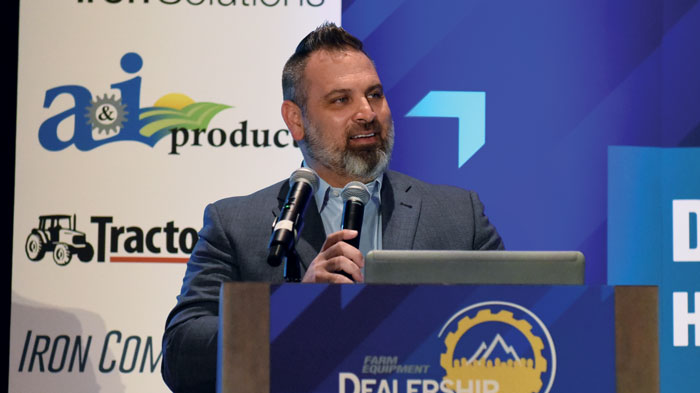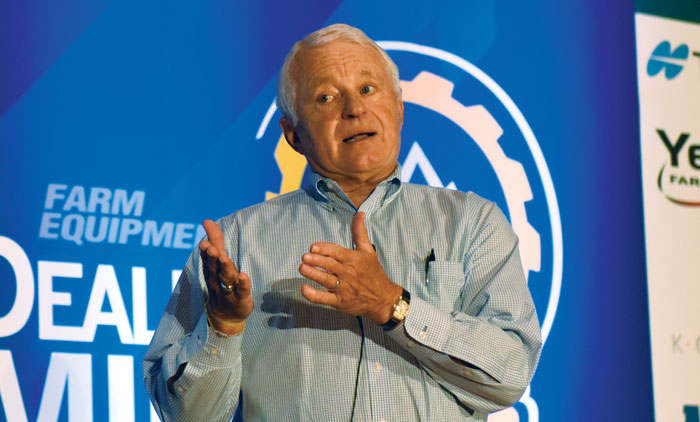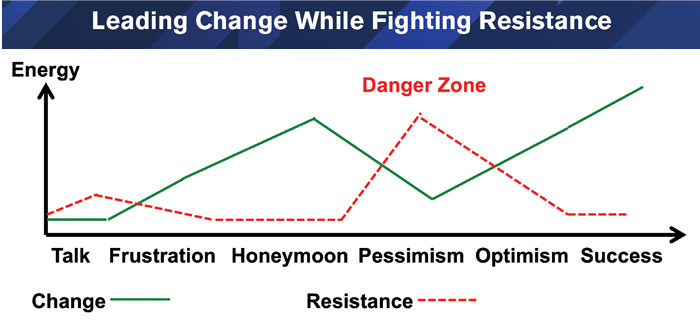Any conversation about a functional equipment industry that sells product to farmers must include workforce development, simply because the agriculture industry is such a niche of the overall power equipment industry.
Michael Piercy, vice president of dealer development, Western Equipment Dealers Assn., says workforce development is one area that divides low and average performing dealers.
“When you look at the approach to workforce development in our industry, it’s like so many other things,” Piercy says. “We tend to run 10-20 years behind other leading industries.”
Most organizations that have difficulty with workforce development have a reactive approach, according to Piercy. Those dealers consider the investment and training of new employees as a necessary evil and are typically just looking to check a box or show that they have completed a specific task.
“They don’t address the need in workforce development until something falls apart or there is a major issue caused by the lack of development in a particular skillset,” Piercy adds. “The reaction is to throw something at it and hope it has a positive impact, or at least contains it somewhat.”
Dealer Takeaways
- Growing your people grows your business, and your business is not going to change until your people change.
- Workforce development brings to the surface the most common underlying attitude of dealers on employee development and performance issues.
- Create a culture where employees feel like the dealer organization is investing in their overall development, which creates higher loyalty and often results in higher performance from the employee base.
This reactive approach is like a bandage, holding together the business for a day, week, month or maybe even a year. In the end, it is not a long-term solution.
Piercy notes that many organizations have a love/hate relationship with employee development through training or consulting initiatives, mostly because most organizations have never found a system for implementing or developing a consistent standard across the organization.
“Dealers and leaders often become firemen, chasing the smoke and putting out fires wherever they rise, instead of addressing the root cause and mitigating as much of the random pop-ups as possible,” Piercy says.

Michael Piercy says most dealers don’t address the need in workforce development until something falls apart or there is a major issue caused by the lack of development in a particular skillset. The reaction is to throw something at it and hope it has a positive impact, or at least contains it somewhat.
Low performing dealers view employee investment as something they have to do. Workforce development brings to the surface the most common underlying attitude of dealers on employee development and performance issues.
“The combination of these things, I believe, exposes the reason why so many struggle to maintain high-quality staff or attract high-quality talent,” says Piercy.
Be Proactive, Invest in Employees
By contrast, high-performing dealers use a simple but powerful approach to workforce development.
“There is a paradigm shift from the old way of thinking and doing business,” Piercy points out. “Most of these dealers learn to be proactive, invest in their employees, and realize that those two things coupled together help guide their organization to success.”
High-performing dealers do not wait for a problem to exist. They are proactively doing what they can to eliminate it and identifying developmental needs. They are proactive in providing avenues for employees to improve their skillsets. A multi-faceted approach is offered for employees to seek out and fulfill their need to grow, including in-house manufacturer training and/or third-party providers.
“Most high-performing dealer organizations have a definitive path created for employees to see how to get from where they are today to where they want ultimately to be,” Piercy says. “These organizations have created a culture where employees feel like the dealer organization is investing in their overall development, which creates higher loyalty and often results in higher performance from the employee base.”
However, Piercy says that managers should also be conscious of employees’ personal development.
“When you look at the approach to workforce development in our industry, we tend to run 10-20 years behind other leading industries…” – Michael Piercy, Vice President of Dealer Development, Western Equipment Dealers Assn.
“The recognition of the personal development piece is vital to the success of the success of an organization’s plan for employee satisfaction, as well as recruiting and retaining high-quality talent,” Piercy says.
Being proactive and investing in employees is not just something that bigger dealers can accomplish, according to Piercy. Small organizations can do it, too.
“You just have to take the first step,” Piercy encourages. “You cannot just sit back and do the exact same thing and expect something to change.”
Piercy says that dealers and managers should make it their life’s mission to help their average employees become the best they can be.
“If you can’t attract the high-quality, and all you have is average, do everything you can to build that person up and give them the fullest opportunity,” Piercy says. “We need to make sure we are doing everything that we can in our workforce to ensure that all employees have ample opportunity.”
Push Employees Out of Their Comfort Zone
When beginning to roll out a talent development program, dealers have a responsibility to make sure there is a relationship between the technical and people aspects of the business, according to Dr. Larry Cole, a psychologist by training and a trainer and consultant with WEDA’s Dealer Institute. .
“Of those two skillsets, which one is the most important?” Cole asks. “It takes both, but the people side is most important — our interpersonal skills.”

Psychologist Dr. Larry Cole says that accountability is a teaching tool, and supervisors’ number one responsibility is to teach and hold people accountable.
Anyone can learn interpersonal skills as long as a person is emotionally stable. Coaching employees on interpersonal skills comes down to one thing: integrity.
“When you act like a horse’s butt, we’re teaching other people they can act like a horse’s butt, too,” Cole says. “The number one responsibility of a supervisor is to develop talent.”
Everything done by a supervisor sends a message to employees. Pushing employees out of their comfort zone is what supervisors should be doing.
“Talent development ought to be folded into your vision and mission,” Cole says. “Growing your people actually grows your business, and your business is not going to change until your people change.”

Larry Cole says it’s essential to understand and use the necessary tools to manage the energy systems inherent in the change process. The graph above illustrates the typical organizational change effort. The management structure must understand how to use the “two whys” tools and confidently use optimism to overcome the temptation to quit during the danger zone.
Organizations do a terrible job at helping people manage change, according to Cole. The only way employees will change is when the disadvantages exceed the advantages.
“Change is nothing more than an energy system,” Cole says. “We’re either going forward or we’re staying here.”
There are two reasons why change should happen, Cole adds. Those reasons are helping people recognize there is a need to change and helping people identify the value in change.
“Having a growth mindset means that any employee can grow,” Cole adds.
Accountability is a Teaching Tool
Accountability typically has a negative connotation, according to Cole, because people associate accountability with a disciplinary process. However, this perspective is not accurate.
“Accountability is a teaching tool,. Our number one responsibility as supervisors is to teach, so it’s our responsibility to hold people accountable,” he adds.
Holding employees accountable means that expectations must be established and defined.
“The number one identified reason for under performance is that people don’t know what’s expected,” Cole says. “Number two is supervisors. They have to walk the talk and teach it.”
Cole says the lack of accountability is a terrible sin, resulting in the failure of 70% of the efforts to make a change in organizations.
“Change is hard work,” Cole says. “You’ve got to establish some kind of communication system so that you know what is going on to monitor the progress that is happening in your dealership.”
Supervisors and leaders have to establish monitoring systems, not to be confused with micromanaging.
“When you act like a horse’s butt, we’re teaching other people they can act like a horse’s butt, too…” – Dr. Larry Cole ,Trainer & Consultant,WEDA Dealer Institute
“Micromanaging is telling people when to do it, how to do it and if I want your input, I’ll ask for it,” Cole says. “Instead, we have to plant the seeds.”
Guide Employees’ Journey, Passion
Leadership development is a journey, starting with the self. When an employee is at the beginning of their leadership development journey, it is a responsibility.
“Some people are going to take their journey and self-actualize by taking the resources given to them and becoming the best version of themselves that they can possibly be,” Cole says.
“If everybody in a dealership had the mindset, ‘We are not only here to help our customers to succeed, but to help each other, what would happen to the disagreements and conflict in your organization?”
Supervisors must want to help their employees succeed. That means asking employees where they want their career to take them.
Some employees are only in a job for the money or as a career, while a few employees are in a job because it is a calling.
“This is where everyone wants to be,” Cole says. “We want people to say, ‘I would pay you to allow me to work here.’”
“The ‘why’ an employee is doing what they are doing is high performance fuel for passion,” Cole says. “You and I can control our passion like a thermostat, by controlling the two whys.”
In developing talent, employees should be taught how to manage their own personal change, according to Cole.
“It’s not rocket science,” Cole says. “You have to know what to teach. All of us need to learn to bounce back. All of us are going to experience frustration.”
Skill development is making progress, then reaching a plateau, and then repeating that process.
“It’s not a straight-line function,” Cole notes. “Sometimes it feels like we take two steps back to go one step forward.”
Leaders must demonstrate resiliency through optimism, even when things do not go well, Cole admonishes.
Although many equipment dealerships in the agriculture industry are family-owned businesses, Cole notes family members should not be treated with special leniency. They must be treated with the same accountability as unrelated employees.
“Leaders should be willing to pay the price,” Cole says. “Without feedback, there is not going to be improvement in performance. Unfortunately, many supervisors are not really good at providing feedback.”
Because feedback is the only way to improve performance, it is important to substitute one behavior for another.
“As soon as you start talking about talent development, resistance is going to increase,” Cole says. “Good enough is never good enough.”
Remaining as-is is not an option. However, change is hard work and it does not occur as fast as you want.
Cole says there is also a difference between recognition and appreciation. Tell employees thank you for doing X because it is going to help the organization get to Y.
“Psychologically, small wins are more important than a homerun,” Cole says. “Job crafting is an opportunity for employees to develop their own job responsibilities and descriptions,” Cole says. “As part of that, they also do shadowing and cross training and are mentored by an internal coach.”
Facing Reality: Dealers Must Develop Their Own Home-Grown Talent Why Executives Should Train the Next Generation of LeaderDeveloping Leaders Takes Time but Yields Big ResultsHow to Identify, Develop & Retain Your Dealership’s Next Generation of LeadersLeadership Development Must Be ProactiveCollege Recruitment Programs Help Alleviate Hiring Crunch






